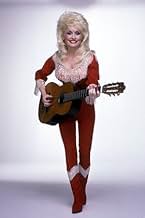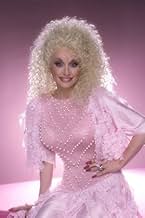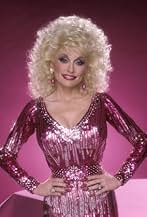Adicionar um enredo no seu idiomaDolly Parton's second short-lived variety series.Dolly Parton's second short-lived variety series.Dolly Parton's second short-lived variety series.
- Ganhou 1 Primetime Emmy
- 1 vitória e 1 indicação no total
Explorar episódios
Enredo
Você sabia?
- CuriosidadesBy the time this show debuted, Dolly had "gone mainstream" and a significant portion of Parton's fan base were not necessarily fans of country music, yet the producers in charge of booking guest artists leaned heavily on country legends like Tammy Wynette and Merle Haggard. As a result, despite debuting to an enormous audience of more than 39 million viewers, the ratings dwindled over time to where ABC's guarantee of a two year run was abandoned, and Dolly was canceled in the spring of 1988.
Avaliação em destaque
The variety show had been a staple since the earliest days of television, but throughout the 80s the genre was on the verge of extinction. Enter Dolly Parton, a tiny country singer with a big voice, a big heart and even bigger physical attributes who'd made a meteoric rise from twangy country singer to pop star to movie star, becoming an international household name in the process. Dolly had gotten her big break appearing as a regular for 6 years on the "Porter Wagoner Show" and she hosted a short-lived syndicated show of her own in 1976, so when she approached them with the idea, ABC decided to take a chance and attempt to revive the variety format with this experienced lady who was now one of the biggest superstars in the world (and whom had recently undergone a flabbergasting surgical weight loss). Dolly was contracted for two seasons and paid a million dollars an episode... and as a savvy businesswoman with the new theme park Dollywood to look after, it was stipulated that she'd receive the $44 million whether or not the show was prematurely canceled. On top of her exorbitant salary, they spent an additional million per episode on production costs, often taping more material than they needed (scenes with Dolph Lundgren, Minnie Mouse and others never aired).
Making its big debut, "Dolly" was a real product of its time, filled with Dayglo colors, corny comedy, and a who's-who of '80s celebrities. As they were heading into production, the singer was focused on her over-synthesized new pop album "Rainbow," which was D.O.A. at record stores and her last major foray into pop music. As such, she let the producers develop much of the show's format, including a weekly skit that caused minor controversy called "Dolly's Date" in which a male celebrity (ranging from Bruce Willis to Pee Wee Herman to Jon Lovitz) would have a cheesy "date" with the long-time-wedded hostess. Other recurring skits included "Vanity Fair," in which Dolly portrayed a hairdresser named Velma, and "Dixie's Place," where (utilizing her real-life husband's last name) she was truck stop waitress Dixie Lee Dean. The latter was particularly interesting because the tone veered toward dramedy and there was a recurring cast with truckers Bubba (Walter Olkewicz) and Charlie (Ritch Brinkley), as well as chef Carlos (Sal Lopez).
Dolly was along for the ride at first but following a strong premiere, ratings began to plummet so she took a more hands-on approach. The glossy opening-theme re-recording of "Baby I'm Burning" was replaced by a live rendition of "Hoedown Showdown," she dropped all of the skits except "Dixie's Place," the TV celebrities got the boot in favor of popular country acts, her singing segments were expanded, and there were several themed episodes. For Thanksgiving, she shot an episode in her hometown, the Christmas show was a garish tinsel-fest filled with singing children, there were quasi-educational episodes in Hawaii and New Orleans, and she headed to Nashville, where she reunited with Porter Wagoner after a more than decade-long feud.
The show became something kind of special but despite her valiant efforts, ratings didn't improve, with most viewers opting to watch the movie-of-the-week that played opposite (or, for those who could pick up the station, watching Tracey Ullman's and Gary Shadling's shows on the new Fox network). When Dolly won a People's Choice Award for hosting the show, she quipped, "I don't think the same people who work the Neilsen boxes voted for this." At the end of the first season, the series was canceled, marking the final network attempt at a full-blown weekly variety show until Neil Patrick Harris's shorter-lived "Best Time Ever" in 2015.
Despite the lack-of-success, Parton was proud of the series and kept clips running on a loop at her Dollywood museum. Similarly, fans still seem to be gaga over it, with a variety of fan-uploaded You Tube videos racking up millions of hits. It's a shame that the show wasn't given a second year to blossom, and that it's never been issued on legal home media. Although there were some rocks, there were more of nuggets of gold, and the show's definitely essential for her fans to seek out.
Making its big debut, "Dolly" was a real product of its time, filled with Dayglo colors, corny comedy, and a who's-who of '80s celebrities. As they were heading into production, the singer was focused on her over-synthesized new pop album "Rainbow," which was D.O.A. at record stores and her last major foray into pop music. As such, she let the producers develop much of the show's format, including a weekly skit that caused minor controversy called "Dolly's Date" in which a male celebrity (ranging from Bruce Willis to Pee Wee Herman to Jon Lovitz) would have a cheesy "date" with the long-time-wedded hostess. Other recurring skits included "Vanity Fair," in which Dolly portrayed a hairdresser named Velma, and "Dixie's Place," where (utilizing her real-life husband's last name) she was truck stop waitress Dixie Lee Dean. The latter was particularly interesting because the tone veered toward dramedy and there was a recurring cast with truckers Bubba (Walter Olkewicz) and Charlie (Ritch Brinkley), as well as chef Carlos (Sal Lopez).
Dolly was along for the ride at first but following a strong premiere, ratings began to plummet so she took a more hands-on approach. The glossy opening-theme re-recording of "Baby I'm Burning" was replaced by a live rendition of "Hoedown Showdown," she dropped all of the skits except "Dixie's Place," the TV celebrities got the boot in favor of popular country acts, her singing segments were expanded, and there were several themed episodes. For Thanksgiving, she shot an episode in her hometown, the Christmas show was a garish tinsel-fest filled with singing children, there were quasi-educational episodes in Hawaii and New Orleans, and she headed to Nashville, where she reunited with Porter Wagoner after a more than decade-long feud.
The show became something kind of special but despite her valiant efforts, ratings didn't improve, with most viewers opting to watch the movie-of-the-week that played opposite (or, for those who could pick up the station, watching Tracey Ullman's and Gary Shadling's shows on the new Fox network). When Dolly won a People's Choice Award for hosting the show, she quipped, "I don't think the same people who work the Neilsen boxes voted for this." At the end of the first season, the series was canceled, marking the final network attempt at a full-blown weekly variety show until Neil Patrick Harris's shorter-lived "Best Time Ever" in 2015.
Despite the lack-of-success, Parton was proud of the series and kept clips running on a loop at her Dollywood museum. Similarly, fans still seem to be gaga over it, with a variety of fan-uploaded You Tube videos racking up millions of hits. It's a shame that the show wasn't given a second year to blossom, and that it's never been issued on legal home media. Although there were some rocks, there were more of nuggets of gold, and the show's definitely essential for her fans to seek out.
- VinnieRattolle
- 12 de abr. de 2016
- Link permanente
Principais escolhas
Faça login para avaliar e ver a lista de recomendações personalizadas
- How many seasons does Dolly have?Fornecido pela Alexa
Detalhes
Contribua para esta página
Sugerir uma alteração ou adicionar conteúdo ausente





































